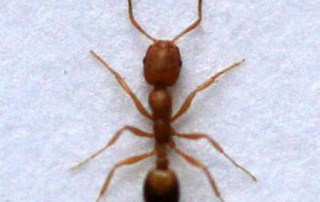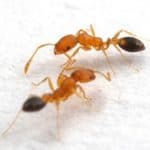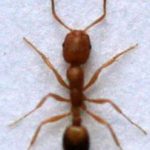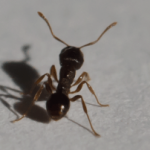Votre panier est actuellement vide !

Pharaoh ant
The workers measure between 1.5 and 2 mm.their color varies from golden to reddish brown.their abdomen, is generally darker than the rest of the body.the color and the small size of these ants make it possible to differentiate the pharaoh ants from other local species.they do not sting.
Latin Name: Monomorium pharaonis
Description:Pharaoh ants are insects that live in a colony.Within a colony there is the caste of reproducers, queens and males,and the caste of workers.The queens are the largest ants in the colonyTheir length varies between 3.5 and 5 mm. Their abdomen ends in an egg-laying organ called the ovipositor.There are many queens in a colony and they can sometimes be seen when they move with workers. The workers measure between 1.5 and 2 mm.Their color varies from golden to reddish brown.Their abdomen, is usually darker than the rest of the body.The color and small size of these ants differentiate pharaoh ants from other local species.They do not sting.
Reproduction:Mating between males and females occurs within the colony rather than during a nuptial flight. The males die soon after while the females begin laying eggs.Each queen produces about 400 eggs in her lifetime.A fertilized egg gives birth to a female (worker or queen), an unfertilized egg to a maleAt a temperature of 27C, a worker will reach the adult stage in 38 days. The workers are the ones who take care of the eggs and larvae. Because of their rapid development, nests can contain thousands of individuals (some colonies have 300,000 or more individuals). A colony can have more than one queen and each queen can eventually move on to found another colony. When the colony is overcrowded or during upheavals(a flood or the presence of pesticides), one or more queensof workers and their brood will separate from the main colony to settle elsewhere.This is called colony splitting.Each « satellite » nest includes several laying queens, making it very difficult to eradicate them once they are established in numbers.
Habits:In temperate climates, it survives only inside heated buildings.It is especially fond of tropical greenhouses and also hospitals and other medical-social establishments, company restaurants, etc.Colonies of this species have only one form of workers(there are no soldiers, for example, as in other ants).Pharaoh ants are omnivores. Their menu consists of syrup, honey, sugar, fruit juices, sweets, cakes and all sweet substances.They also eat meat and fat; they prey on insect collections and fat-based products such as shoe polish.They sometimes prey on certain insects. They cause little damage to foodstuffs.The main inconvenience they represent is their mere presence.They are most often found in the kitchen or bathroom, near a source of water and heat.They establish their nests in walls, under floors, at the base of buildings and in cracks in stone and cement.


